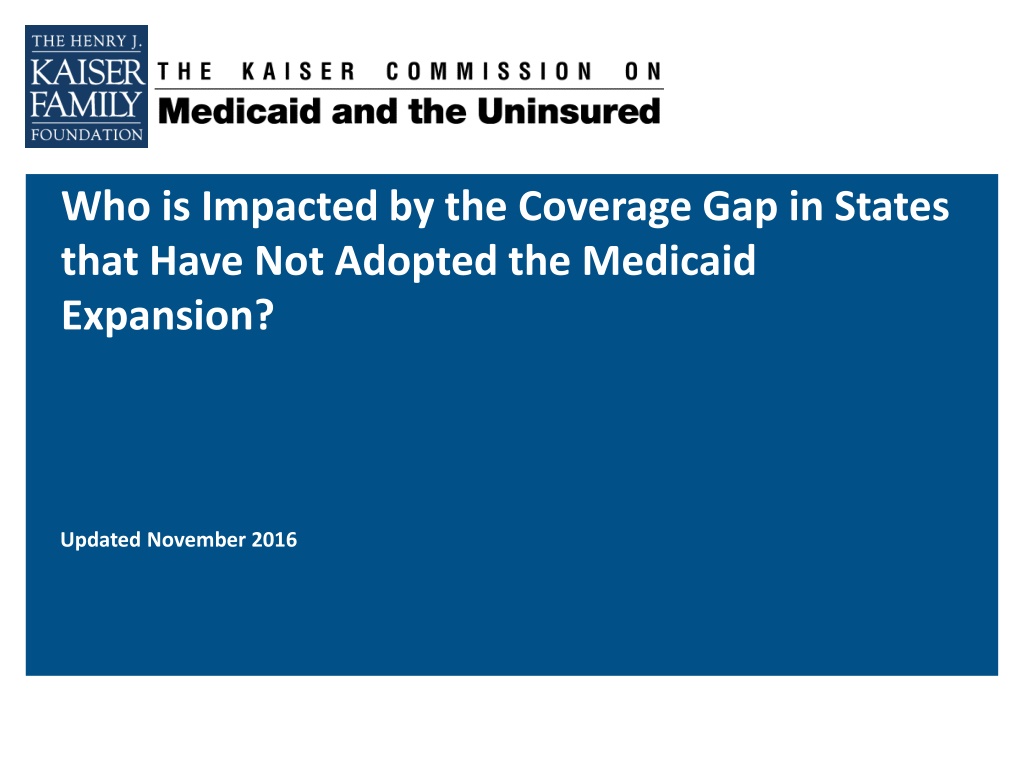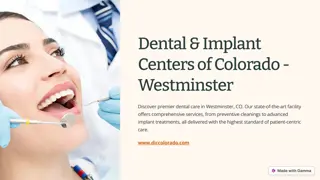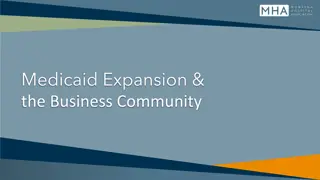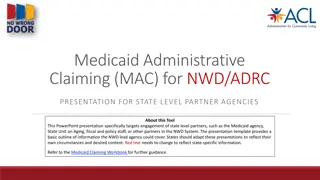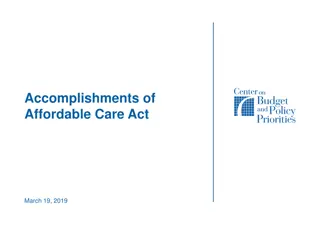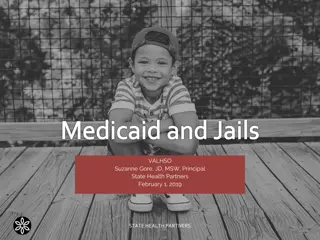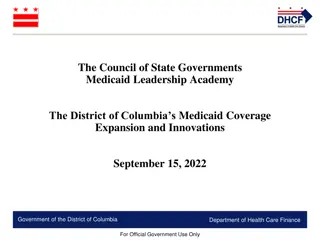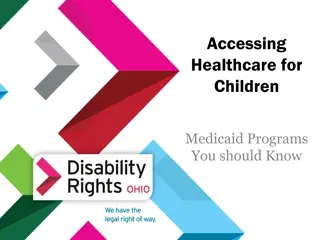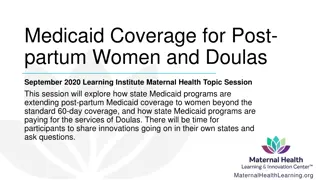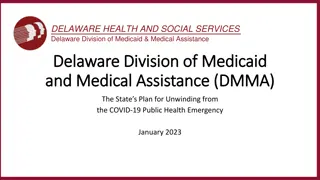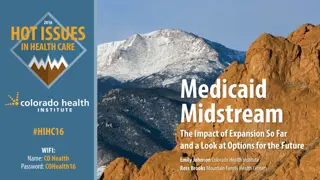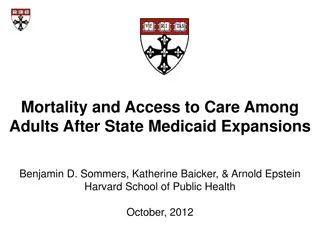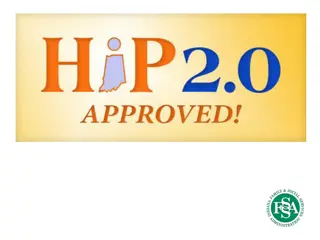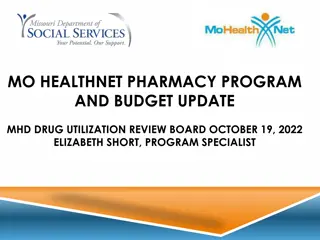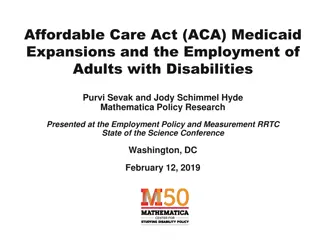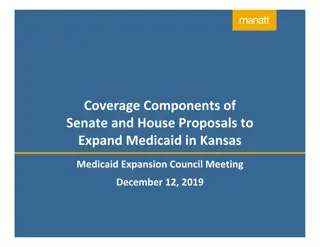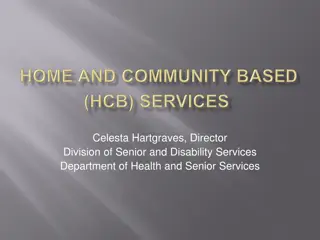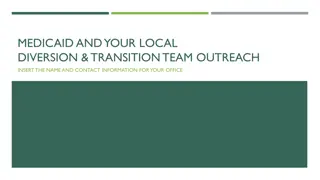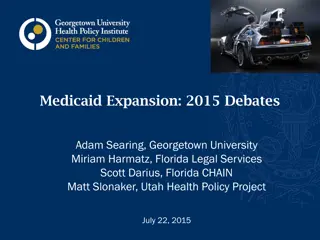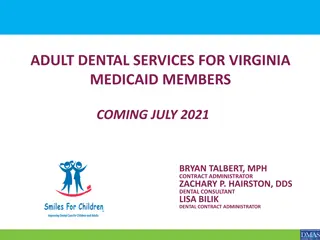Medicaid Coverage Gap Impact in Non-Expansion States
The coverage gap in states without Medicaid expansion affects approximately 28.5 million uninsured nonelderly individuals, with the majority being low-income adults and people of color. The Medicaid expansion under the ACA aimed to fill long-standing gaps in coverage but became a state option due to a Supreme Court decision. This visual representation highlights the demographics and income levels of those impacted by the lack of Medicaid expansion.
Uploaded on Sep 18, 2024 | 1 Views
Download Presentation

Please find below an Image/Link to download the presentation.
The content on the website is provided AS IS for your information and personal use only. It may not be sold, licensed, or shared on other websites without obtaining consent from the author.If you encounter any issues during the download, it is possible that the publisher has removed the file from their server.
You are allowed to download the files provided on this website for personal or commercial use, subject to the condition that they are used lawfully. All files are the property of their respective owners.
The content on the website is provided AS IS for your information and personal use only. It may not be sold, licensed, or shared on other websites without obtaining consent from the author.
E N D
Presentation Transcript
Who is Impacted by the Coverage Gap in States that Have Not Adopted the Medicaid Expansion? Updated November 2016
Figure 1 An estimated 28.5 million nonelderly individuals were uninsured in 2015. Medicaid/ Other Public, 26% Uninsured, 10% Employer- Sponsored, 56% Private Non- Group, 8% 271.3 M Nonelderly NOTES: Medicaid and other public coverage includes: CHIP, other state programs, Medicare and military related coverage. Data may not total 100% due to rounding. SOURCE: Kaiser Family Foundation analysis of the 2016 ASEC Supplement to the CPS.
Figure 2 In 2015, the majority of the uninsured are low-income adults, and more than half are people of color. Family Income (%FPL) Parent Status Race Asian/Native Hawaiian or Pacific Islander Other 3% 5% 400%+ FPL 19% Children <100% FPL 15% White non- Hispanic 26% Hispanic Childless Adults 200-399% FPL Parents 32% 100-199% FPL 26% 45% 59% 28% 27% Black 15% Total = 28.5 Million Uninsured NOTES: The U.S. Census Bureau's poverty threshold for a family with two adults and one child was $19,078 in 2015. Data may not total 100% due to rounding. SOURCE: Kaiser Family Foundation analysis of the 2016 ASEC Supplement to the CPS.
Figure 3 Prior to the ACA, Medicaid eligibility was limited to specific low- income groups. Not Eligible
Figure 4 Expanding Medicaid to low-income adults is a core component of the ACA coverage expansions. Universal Coverage Marketplaces With Subsidies For Moderate Income Individuals Medicaid Coverage For Low-Income Individuals Individual Mandate Health Insurance Market Reforms Employer-Sponsored Coverage
Figure 5 As enacted, the ACA Medicaid expansion would cover adults up to 138% FPL in all states, filling long-standing gaps in coverage. NOTES: 138% FPL = $16,394 for an individual and $27,821 for a family of three in 2016.
Figure 6 But, the Supreme Court effectively made the Medicaid expansion a state option. Status of Medicaid Expansion Decisions, October 14, 2016 VT WA ME MT* ND NH* MN MA NY OR WI* SD ID MI* RI CT WY PA NJ DE IA* NE OH IN* IL NV MD UT WV VA CO DC KS MO KY CA NC TN SC OK AR* AZ* NM GA AL MS LA TX AK FL HI Adopted (32 States including DC) Not Adopting At This Time (19 States) NOTES: Current status for each state is based on KCMU tracking and analysis of state executive activity. *AR, AZ, IA, IN, MI, MT, and NH have approved Section 1115 waivers. WI covers adults up to 100% FPL in Medicaid, but did not adopt the ACA expansion. SOURCE: Status of State Action on the Medicaid Expansion Decision, KFF State Health Facts, updated October 14, 2016. http://kff.org/health-reform/state-indicator/state-activity-around-expanding-medicaid-under-the-affordable-care-act/
Figure 7 Medicaid eligibility for adults remains limited in states that have not adopted the Medicaid expansion. Median Medicaid/CHIP Income Eligibility Thresholds, January 2016 Adopted the Medicaid Expansion (32 states, including DC) Not Adopting at this Time (19 states) 297% 214% 213% 199% 138% 138% 44% 0% Children Pregnant Women Parents Childless Adults NOTE: State-reported eligibility levels as of Jan. 1, 2016, updated to reflect Medicaid expansion adoption in Louisiana as of Jan. 12, 2016. Eligibility levels include the standard five percentage point of the federal poverty level (FPL) disregard. As of 2016, the FPL was $20,160 for a family of three and $11,880 for an individual. SOURCE: Based on results from a national survey conducted by the Kaiser Commission on Medicaid and the Uninsured and the Georgetown University Center for Children and Families, 2016 with data updates based on new state decisions to expand Medicaid.
Figure 8 In states that have not adopted the Medicaid expansion, poor adults fall into a coverage gap, earning too much to qualify for Medicaid but too little for subsidies for Marketplace coverage. 44% FPL $8,870 for parents in a family of three $11,880 $47,520 for an individual for an individual as of January 2016
Figure 9 In 2016, an estimated 2.6 million nonelderly adults fall into the coverage gap, most of whom reside in the South. Distribution By State: Distribution By Geographic Region: Other States that Have Not Expanded Medicaid 36% TX 26% South 91% Midwest 6% FL 18% NC 8% GA 12% Northeast <1% West 3% Total = 2.6 Million in the Coverage Gap Note: Totals may not sum to 100% due to rounding. Source: Kaiser Family Foundation analysis based on 2016 Medicaid eligibility levels and 2016 Current Population Survey data.
Figure 10 More than half of adults in the coverage gap are adults of color. Adults in the coverage gap are of varying age and health status. Distribution By Health Status: Distribution By Race/Ethnicity: Distribution By Age: Other 5% Fair or Poor 21% Hispanic 18% 55-64 years 17% 19-24 years 24% Excellent or Very Good 49% White 46% 25-34 years 21% 35-54 years 38% Good 30% Black 31% Total = 2.6 Million in the Coverage Gap Note: Totals may not sum to 100% due to rounding. Source: Kaiser Family Foundation analysis based on 2016 Medicaid eligibility levels and 2016 Current Population Survey data.
Figure 11 Nearly two-thirds of adults in the coverage gap are in a family with a worker, but most work in jobs that are unlikely to offer insurance. Family work status : Firm size and industry among those working: Other 6% Manufacturing /Infrastructure 11% 100+ Education/ Health employees 12% 48% 16% Professional/ Public Admin Full-time worker 41% No worker 38% 50-99 employees 5% Agriculture/ Service <50 employees 54% Part-time worker 21% 47% Total = 2.6 Million in the Coverage Gap Total = 1.4 Million Workers in the Coverage Gap Notes: Industry classifications: Agriculture/Service includes agriculture, construction, leisure and hospitality services, wholesale and retail trade. Education/Health includes education and health services. Professional/Public Admin includes finance, professional and business services, information, and public administration. Manufacturing/Infrastructure includes mining, manufacturing, utilities, and transportation. Totals may not sum to 100% due to rounding. Source: Kaiser Family Foundation analysis based on 2016 Medicaid eligibility levels and 2016 Current Population Survey data.
Figure 12 Uninsured Black adults are more likely to fall into the coverage gap than other racial/ethnic groups. Share of Uninsured Adults Who Fall into the Coverage Gap, by Race/Ethnicity: 23% 11% 11% 11% 7% 6% Total Whites Blacks Hispanics Other All People of Color 12.7 M Total Uninsured Adults 23.2 M 10.5 M 3.5 M 7.5 M 1.7 M Source: Kaiser Family Foundation analysis based on 2016 Medicaid eligibility levels and 2016 Current Population Survey data.
Figure 13 If all states adopted the Medicaid expansion, the coverage gap would be eliminated and 54% of the nonelderly uninsured would be eligible for financial assistance in 2016. Ineligible due to Immigration Status 20% Ineligible due to Immigration Status 20% Unsubsidized Marketplace/ESI Offer Unsubsidized Marketplace/ESI Offer 26% 27% Tax-Credit Eligible Tax-Credit Eligible 16% Eligible for Financial Assistance 43% Eligible for Financial Assistance 54% 19% Medicaid-Eligible Child 10% In the Coverage Gap 10% Medicaid-Eligible Child 10% Medicaid-Eligible Adult Medicaid-Eligible Adult 14% 29% Based on Current Medicaid Expansion Decisions If All States Expanded Medicaid Total = 27.2 Million Nonelderly Uninsured NOTES: Numbers may not sum to subtotals or 100% due to rounding. Tax-Credit Eligible share includes adults in MN and NY who are eligible for coverage through the Basic Health Plan. SOURCE: Kaiser Family Foundation analysis based on 2016 Medicaid eligibility levels and 2016 Current Population Survey data.
